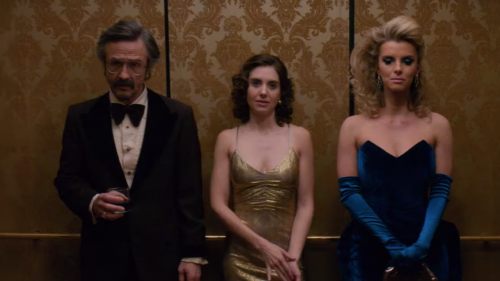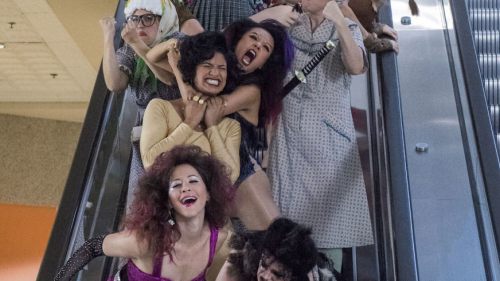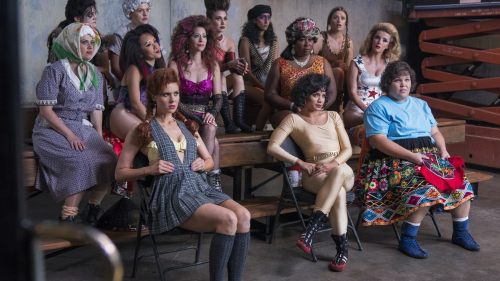GLOW: Divas Or Wrestlers?
On February 23, 2015, an episode of RAW featured The Bella Twins (Nikki & Brie) facing off against Paige and Emma. The match only lasted thirty seconds. Afterward, a hashtag on Twitter trended worldwide for 1.5 days. The demand? #GiveDivasAChance.
One year later, WWE’s female wrestlers are no longer called Divas. They are now known as Superstars, just like their male counterparts, some 36 years after the reign of The Fabulous Moolah, the first female wrestler to be inducted into the WWE Hall of Fame.
Moolah came into her own in the hyper-masculine world of WWF a few years before the production of Gorgeous Ladies of Wrestling, a franchise created by David McLane. McLane, a small town television producer and wrestling fan from Indiana, pushed for more serious storylines for women wrestlers. He wanted to differentiate his show from WWF’s Superstars. Gorgeous Ladies of Wrestling would go on to run for four seasons in adjacent time slots to WWF programming in the 1980’s. It offered a ragtag group of women in LA who wanted to put women wrestling on the same playing field as WWF during the Hulk Hogan and Ric Flair era and was the inspiration behind the Netflix’s original series GLOW.
The Netflix show’s central character, Ruth Wilder, played by Allison Brie, hones her wrestling persona by evoking WWF fighters’ bravado, costumes and dialogue, which she infuses with a unique female twist since she has no female wrestlers to emulate. Ruth and the other women wrestlers are being trained by an ex-WWF Superstar, Salty "The Sack" Johnson (played by John Morrison) who is later fired, leaving creative direction up to the women and the show’s director, Sam Sylvia (played by Marc Maron).
Just as Vince McMahon is central to the identity of WWE, Sam is central to GLOW’s first season. The promoter sets up auditions, oversees the trial and error dress rehearsals and displays a predictable misogyny indicative of the time period. On the first day of auditions, he refers to GLOW as being “just like the big guys, but girls, girl on girl…” reducing women wrestling to some cheapened, athletic erotica. This perception is still present in the modern identity of women’s wrestling. The line between sport and sex is intentionally blurred and at times is overtly sexual.
Half the battle of dignifying women’s wrestling is making it as much about the athleticism, acting and pageantry that defines Superstars like John Cena. It is defying what Sam emphasizes as distinctly female wrestling moves, like hair pulling and “cunt punches”, a term he references twice in less than a minute of being on screen. GLOW expertly plays into this gray area by highlighting wrestling’s essential element of personas, called “gimmicks”. Gimmicks have allowed women wrestlers to gain prestige by invoking empowered personas which led them to win championships, like The Fabulous Moolah in the 1980s and Lita from 2000-2006. Post their success, both women trained generations of female wrestlers just as viewers imagine Ruth will if their first performance at the Hayworth Ballroom is a success.
GLOW’s first season gives viewers an insider's perspective on how difficult it can be to find a suitable gimmick- whether it’s scripted by a writing team or the responsibility of the wrestler to foster. As performance art, wrestling is distinctly unbothered by cultural appropriation. Arthie Premkumar (played by Sunita Mani) is an Indian American pre-med student whose gimmick is "Beirut the Mad Bomber", a Middle Eastern terrorist based on the real Gorgeous Ladies of Wrestling, Palestina. In the show’s season finale, Arthie’s match inspires extreme racism from the audience, who spit on and throw beer cans at her. Safe behind stage, she expresses her disbelief that her performance inspired that kind of reaction. “Those people hated me,” she says.
Why is it that women wrestlers are so often jeopardized by their profession? It is likely because their personas are shaped by antiquated storylines, which must change for the perception of women wrestling to change. GLOW is clever. Each woman’s gimmick represents a stereotype she has spent her life fighting to avoid - the low life living off welfare, the all American bimbo, the self-harming punk, the ghetto trap queen, etc.
I was hired at WWE in the summer of 2015, right after they introduced “The Divas Revolution.” In a male-dominated writers room, a female perspective was needed as WWE’s women wrestlers were expected to rise above their traditional role of full-time arm candy and part-time wrestler to share consistent (though limited) air time with their male, Superstar counterparts.
I learned quickly that this wrestling dynasty hadn’t caught up to the main cultural dialogue around feminism and female empowerment that was electric outside WWE. With a great deal of ground to cover, I realized I would have to embrace the little victories, like storylines that do not hinge on a disagreement over a male love interest, avoiding dialogue where male Superstars reduce female wrestlers by telling them to shut up or by positioning them as getting in the way of their own success.
In comparison, GLOW and the original Gorgeous Girls of Wrestling portray women as their own and each other’s champions. Their gimmicks are self-identified and perfected by their chemistry with one another. This camaraderie defies the historically flawed gender dynamics at WWF and WWE.
Shows like GLOW force wrestling enthusiasts and “girl on girl” fanatics alike to consider just how far women wrestling has come since its inception in a Las Vegas ballroom in the mid-eighties. No longer a sideshow, women wrestlers have demonstrated that they are more than anything, fighters, and deserve a league of their own.



